Over the past few years, the debate between two popular eCommerce platforms, Zoho Commerce vs Shopify, has been heating up. Some still firmly believe that Shopify is the reigning champion, while others argue that Zoho is quietly building the features and flexibility needed to take the crown.
So, which platform really comes out on top? Let us help you answer that question! In this article, we'll compare Zoho Commerce and Shopify across seven key criteria:
- eCommerce features
- Ease of use
- Themes and customization
- Apps & extensions
- SEO & Marketing features
- Customer support
- Pricing
Let's get started!
Our Quick Verdict on Zoho Commerce vs Shopify
If you're looking for the short answer, here it is: Shopify wins overall – but not without some important caveats.
Shopify pulls ahead with stronger inventory management, broader payment options, more flexible design customization, a massive app ecosystem, and a marketing toolkit that grows with your business. However, keep in mind that all that power comes at a price, namely higher monthly fees and potential transaction costs (unless you use Shopify Payments).
Therefore, we’ll recommend Shopify for:
- Fast-scaling businesses that need room to grow with advanced features
- Store owners who want access to 13,000+ apps and deep third-party integrations
- Sellers who prioritize global payments, multichannel selling, and professional storefront design
- Merchants with large inventories or complex variant needs
- Users who don’t mind paying more in exchange for unmatched scalability and customization
Zoho Commerce, on the other hand, still wins in a few key areas. It's more affordable across the board and delivers more structured, hands-on customer support, especially if you like the idea of reaching a real human without much hassle.
We recommend Zoho Commerce for:
- Small to mid-sized businesses on a tight budget
- Users already within the Zoho ecosystem (e.g., Zoho CRM, Zoho Campaigns)
- Merchants operating in regions where Zoho offers strong local support
- Store owners who prefer simplicity and don’t need deep app integrations
- Beginners who want lower costs and are fine with fewer customization options
Both Shopify vs Zoho Commerce have their strengths, and depending on what you value most (cost, scalability, support, or customization), the “best” choice might look different for you. Keep reading as we discuss all the details!
Need Help To Migrate to Shopify?
LitExtension provides a well-optimized All-in-One migration service for you!

Zoho Commerce vs Shopify: Pros & Cons
Zoho Commerce is a strong choice if you're looking for an affordable, no-fuss eCommerce platform. The platform also offers a fairly good set of built-in marketing and SEO tools, and it integrates easily with other Zoho products like Zoho Campaigns and Zoho CRM.
However, keep in mind that Zoho's app and extension ecosystem is very thin. Worse, it only offers around 20 themes, which feels extremely restrictive if you want a lot of design flexibility.
Zoho Commerce Pros | Zoho Commerce Cons |
Affordable pricing plans | Limited app ecosystem |
No transaction fees | Only 20+ templates |
Structured, regional phone support | Less flexibility for external integrations |
Good built-in marketing and SEO tools | Customization feels boxed- in outside Zoho ecosystem |
Shopify offers over 240 themes, access to a 13,000+ app store, and global payment integrations right out of the box. Its built-in marketing tools, clean dashboard, and easy-to-use customization options (including full code access) make it one of the most scalable eCommerce platforms out there.
That said, its direct customer support could be better; there’s no live phone or email support for merchants by default.
Shopify Pros | Shopify Cons |
240+ themes and highly customizable | Higher monthly subscription costs |
13,000+ apps and powerful integrations | Transaction fees unless using Shopify Payments |
Built-in marketing and automation tools | No direct phone or email support |
Scales easily for businesses of all sizes | May require hiring Shopify Experts for complex issues |
Zoho Commerce vs Shopify: 2025 Comparison
1. Best for eCommerce features: Shopify
When setting up an online store, you clearly cannot just simply list tons of products and hope for the best! Every successful eCommerce merchant needs the right tools to manage their inventory, accept payments easily, and ship orders without a hitch, whether on Zoho or Shopify:
Inventory Setup
Both Zoho Commerce vs Shopify make it pretty simple to bulk-upload your products using CSV or XML files, so you won't have to manually add everything one by one!
However, when it comes to bulk uploading images, Zoho stumbles a bit since you'll still have to upload images separately. Obviously, that can quickly get tedious if you have a large catalog.
Zoho also feels limited when it comes to product variants. Sure, it doesn't clearly say how many variants you're allowed per product. But in practice, we can confirm it's far fewer than 100 — not ideal if you sell items with lots of options. Plus, while Zoho offers a global inventory system (great for international sellers), tracking stock across multiple warehouses becomes both confusing and clunky as a result.
Shopify, on the other hand, is much more flexible in this regard. The platform recently boosted its variant limit to an impressive 2,000 variants per product to give you tons of freedom to list every size, color, and style you want.
Managing inventory across different locations is easier, too: you can track stock at up to 10 locations with regular Shopify plans and up to 200 locations if you're on Shopify Plus. That's a huge advantage for anyone growing or already operating in multiple places!
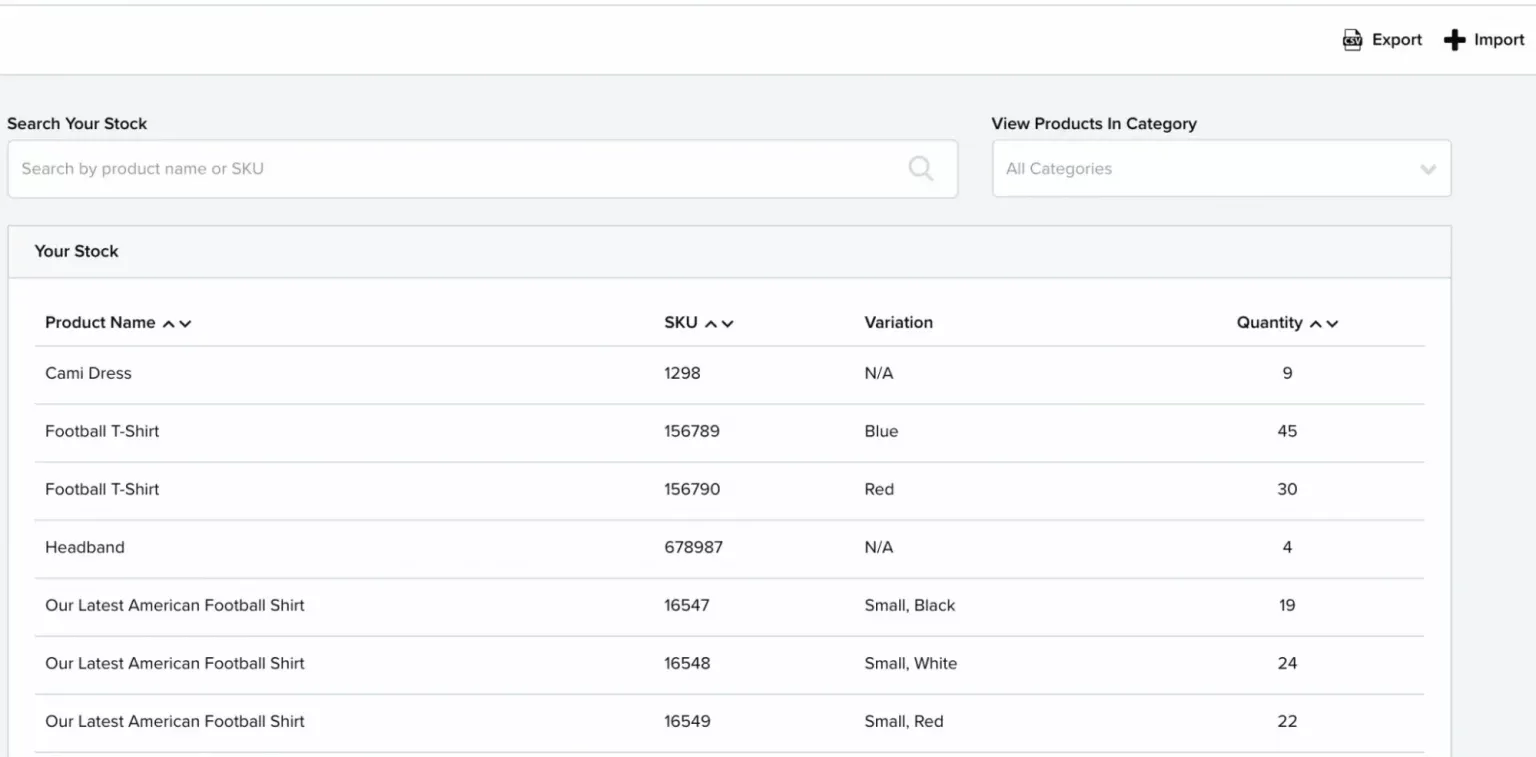
Payment
As of this writing, Zoho offers integrations with around 20+ third-party payment gateways. It even has its own native solution called Zoho Payments, a neat concept that centralizes different gateways in one place. But there's a catch: Zoho Payments is only available in the U.S. and India for now, so international sellers still need to stick with external options.
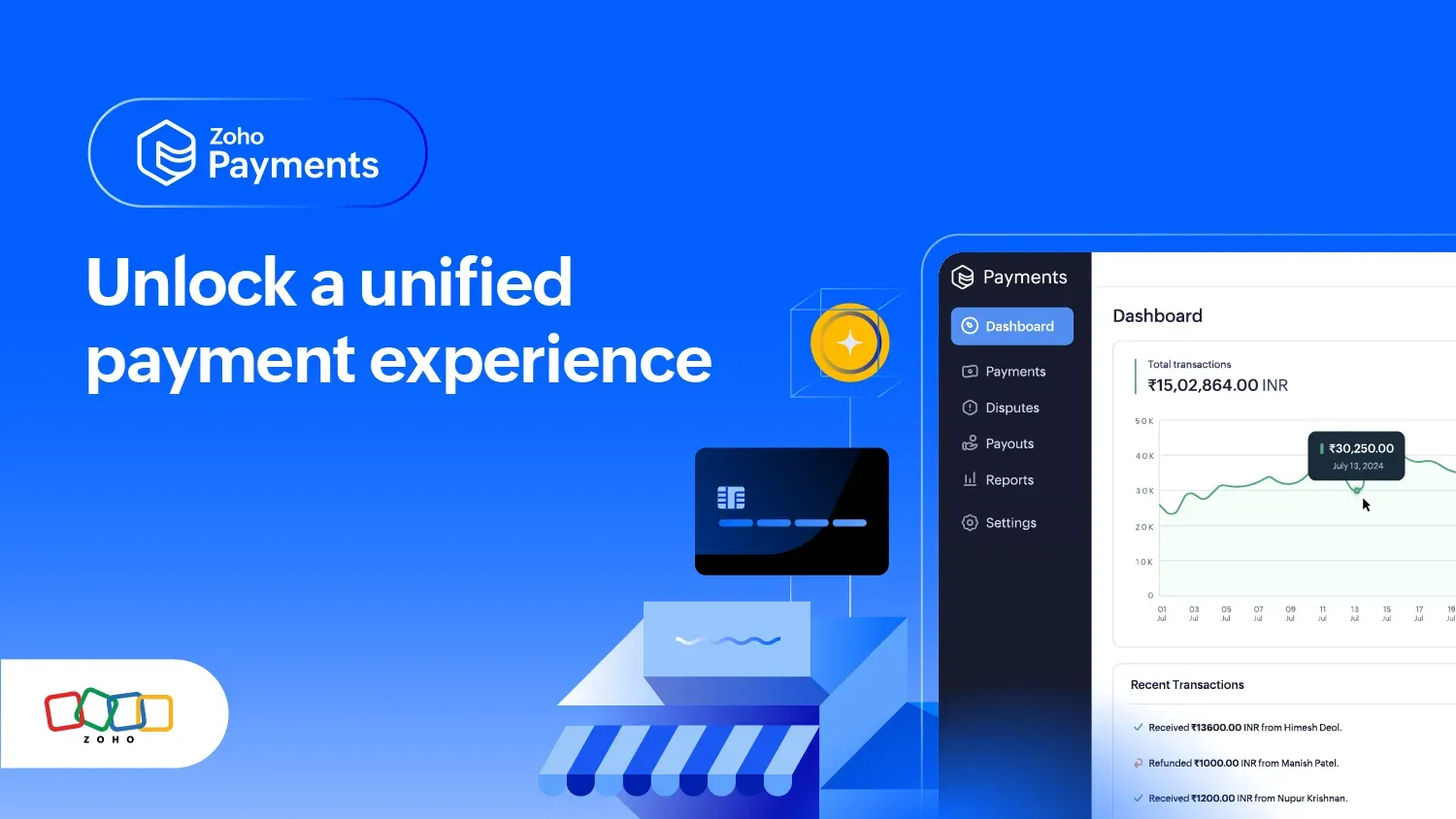
Meanwhile, Shopify's payment setup is a lot more global: according to our research, it connects with over 100 different payment providers worldwide. Plus, Shopify Payments (similar to Zoho Payments) is built directly into the platform and available in many countries, covering everything from credit cards to local payment methods.
And that's not all, if you're selling to customers in the U.S. or Canada, Shopify even offers Shop Pay Installments. Customers can split their payments over time while you still get the full amount upfront; that's a clear win-win for boosting conversions.
Shipping
Now, shipping is one area where Zoho and Shopify are actually on pretty even ground. Both platforms give you flexible shipping options, like flat-rate shipping, weight-based rates, price-based rates, and international shipping. They also integrate with 10+ major carriers, such as FedEx, UPS, DHL, USPS, Canada Post, Australia Post, and more.
More importantly, both Zoho and Shopify team up with Easyship, opening the door to over 550 courier services worldwide. Basically, you'll have plenty of choices for getting your products into customers' hands, whether you're shipping locally or internationally.
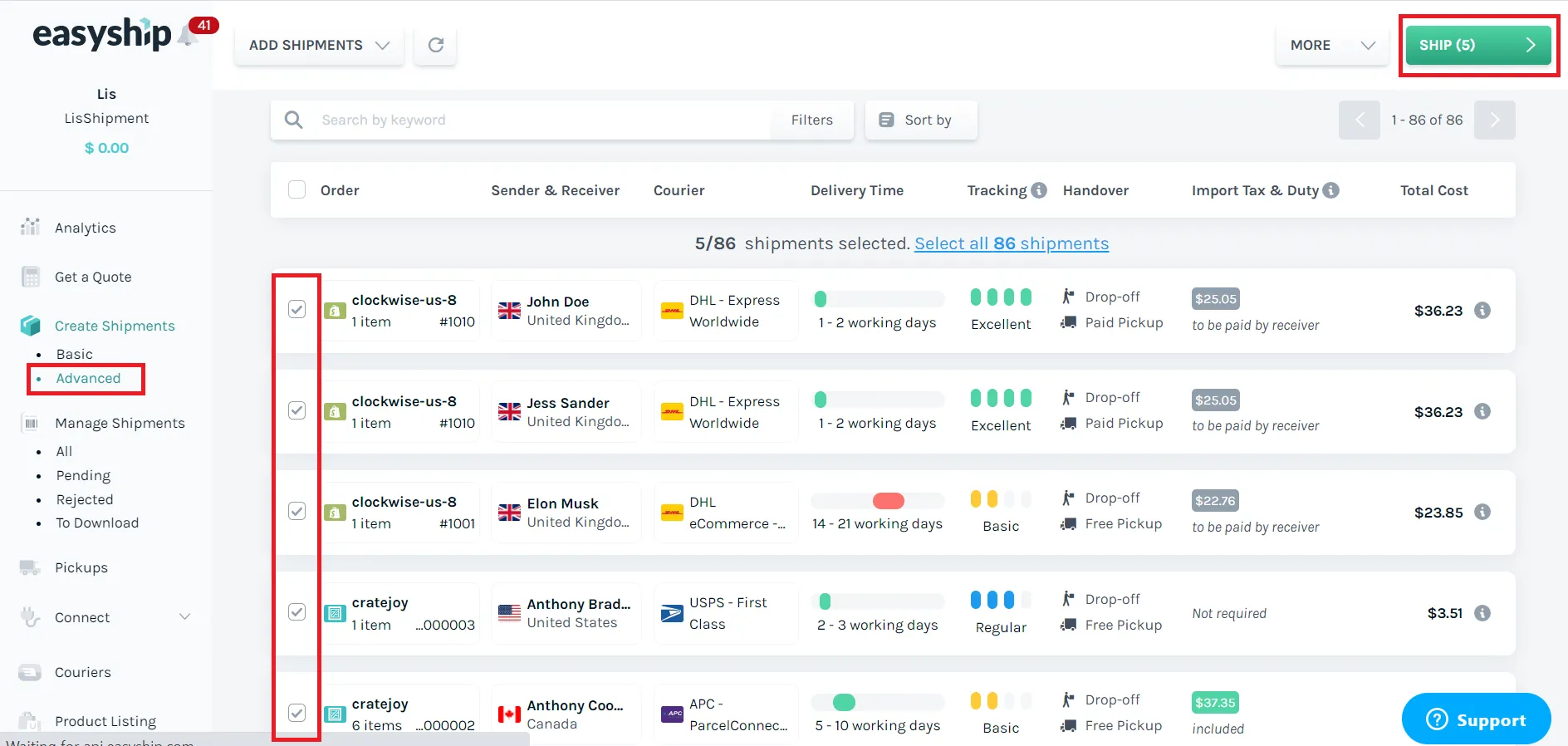
The Verdict
At the end of the day, both Zoho and Shopify give you strong tools to build and run your eCommerce store. Still, if inventory management and payment flexibility are top priorities for you, Shopify definitely pulls ahead.
2. Best for Ease of use: Shopify
Aside from the main eCommerce features, how easily you can hit the ground running also plays a huge role here. After all, if setting up your store feels like pulling teeth, you're wasting time (and probably patience) before you even make your first sale!
Zoho Commerce ease of use
On paper, getting started with Zoho Commerce looks wonderfully simple. You choose a pricing plan, pick a theme, upload your products, and then adjust a few settings. And just like that, you're ready to launch! Even total beginners will find the store-building process clear and fairly intuitive once they're inside the platform.
But the real challenge with Zoho hits you earlier, right at account creation.
- If you try signing up manually with your email and password, be ready for some guesswork. Zoho doesn't clearly explain what kind of password it wants, so you'll likely find yourself typing, deleting, and retrying a few frustrating times before something finally works.
- Thinking you can save time by signing up with Google or LinkedIn? Good idea — but not always a guaranteed shortcut. Zoho sometimes glitches during the social login process and throws out vague “try again later” errors that can leave you stuck at the door.
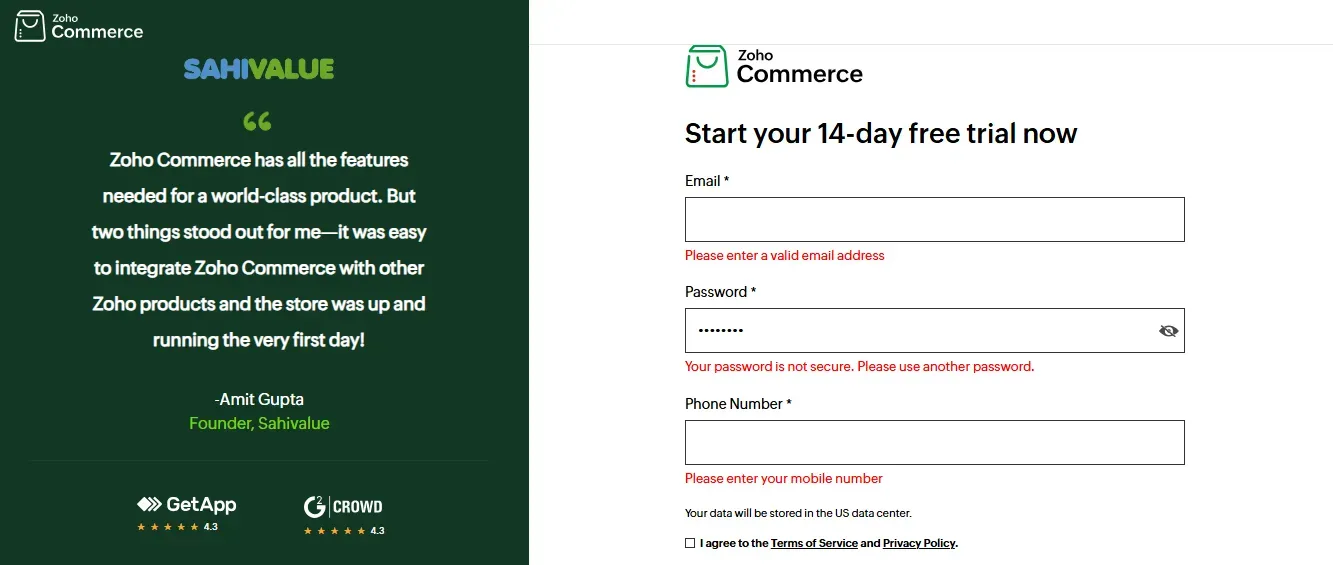
Yes, all of this is not a deal-breaker. But it's a clumsy start nonetheless — and for something as basic as signing up, it really shouldn't be.
Shopify ease of use
For Shopify, you hit “Start Free Trial,” answer a few quick, non-intrusive questions about your store, and sign up with your email or your Google/Apple account. That's it!
Shopify does nudge you to pick a subscription plan pretty early, but if you're not ready to commit yet, no problem; just skip that and explore the dashboard first.
And speaking of dashboards, Shopify's is one of the cleanest around. Everything you need — products, orders, customers, settings — sits neatly on a left-hand menu. Most sections come with helpful little tips and explanations, too, so you won't feel overwhelmed even if you're a complete newbie.
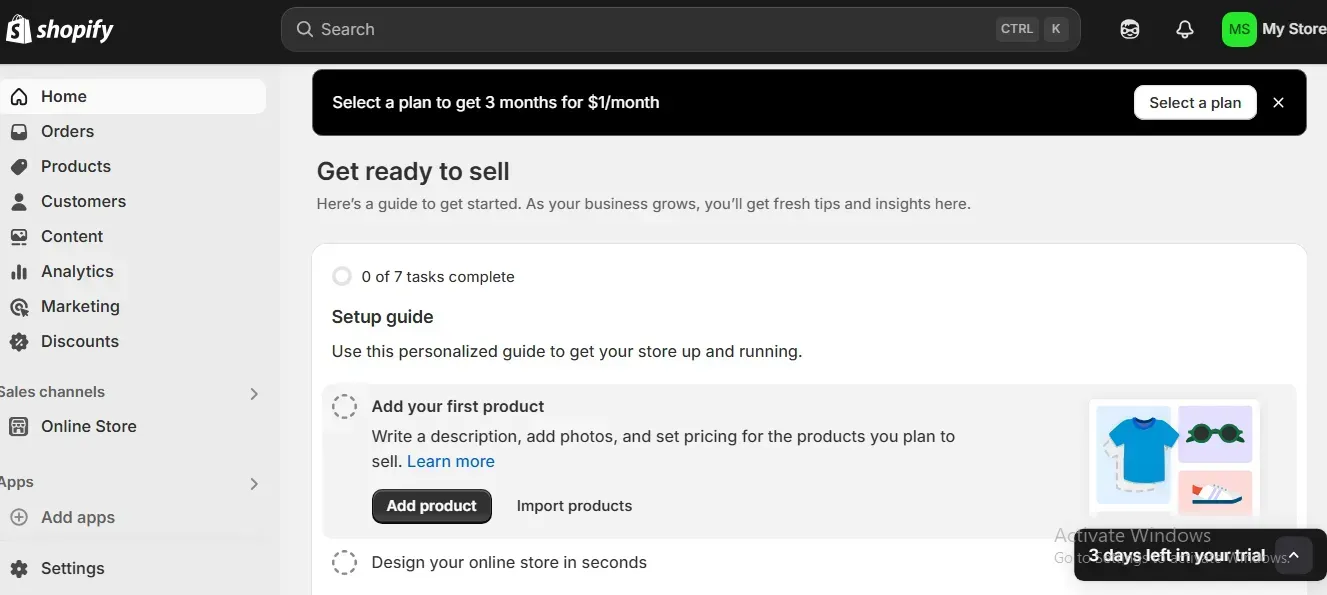
The Verdict
Both platforms work hard to make life easy for store owners once you're fully inside. But when it comes to first impressions. Because of that, Shopify takes the win here.
3. Best for Themes and customization: Shopify
Your store's design is the first thing people notice, and whether they stay to shop often depends on how polished (and personal) your site looks! That's why it's not enough for an eCommerce platform to just offer a few nice-looking templates. You need real freedom to make your store your own:
Zoho Commerce themes and customization
If you're hoping for lots of design choices with Zoho Commerce, you might feel a little boxed in. Right now, Zoho offers around 20 ready-made templates, and that's it. The themes do a decent job covering different industries, and they're pretty easy to tweak thanks to simple preset options you can turn on or off without any coding.
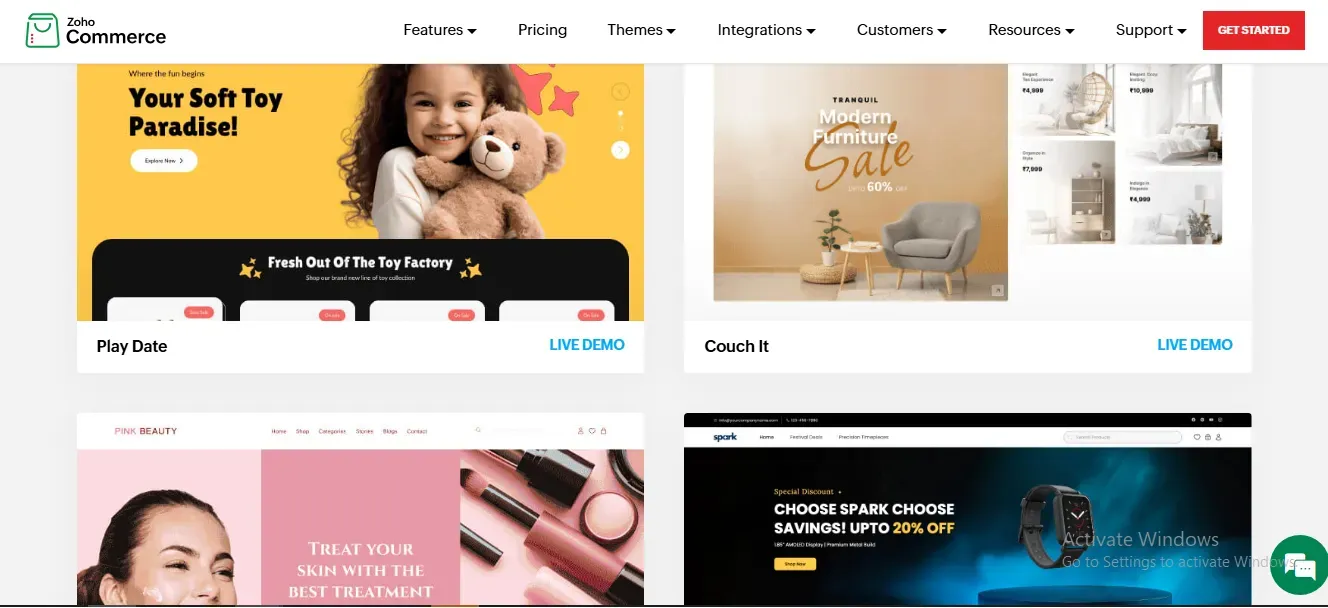
Want to push the design further? You do get a few basic coding tools:
- A Custom CSS Editor to tweak styling details.
- Header and Footer Code Injection to drop in bits of HTML, CSS, or JavaScript.
- Code Snippets you can reuse across your pages.
It's enough for basic adjustments like color tweaks, minor layout fixes, or adding a live chat widget. Nevertheless, you don't get full access to the theme's underlying files or a real code editor, which seriously limits what you can do beyond surface-level changes.
Shopify themes and customization
How about Shopify?
First off, there's no shortage of themes. You'll find over 240 options, from free templates to premium designs that cost up to $500. They're regularly updated, so you won't be stuck choosing from outdated styles.

Customization is also very flexible. For non-coders, Shopify's visual editor lets you easily rearrange sections, change fonts, switch color schemes, and more with a few clicks.
And if you are comfortable with coding (or you have a developer), Shopify really opens up, as you can:
- Get full access to the theme's code, such as HTML, CSS, JavaScript, and Liquid (Shopify's own templating language).
- Make dynamic, personalized changes and show different products to different customers based on behavior.
- Add custom tracking pixels and scripts easily if you need advanced marketing or analytics tools.
In short, it doesn't matter whether you want a drag-and-drop experience or a fully custom-coded masterpiece. Shopify gives you the tools to do either or both!
The Verdict
Shopify wins this round by a mile. With way more theme choices, deeper design control, and full code access, it's clearly the better platform for anyone who wants their store to stand out from the crowd.
4. Best for Apps & extensions: Shopify
No matter how powerful Zoho Commerce vs Shopify claims to be, there’s always something extra you’ll eventually need: a better marketing tool, a smarter inventory tracker, or maybe just a quicker way to handle shipping. That’s where apps and extensions come into play:
Zoho Commerce apps & extensions
Zoho Commerce plugs into the broader Zoho Marketplace, which sounds impressive at first. After all, there are over 2,500 extensions available across Zoho’s full suite of products! But when you narrow it down to Zoho Commerce specifically, the reality is a lot less exciting.
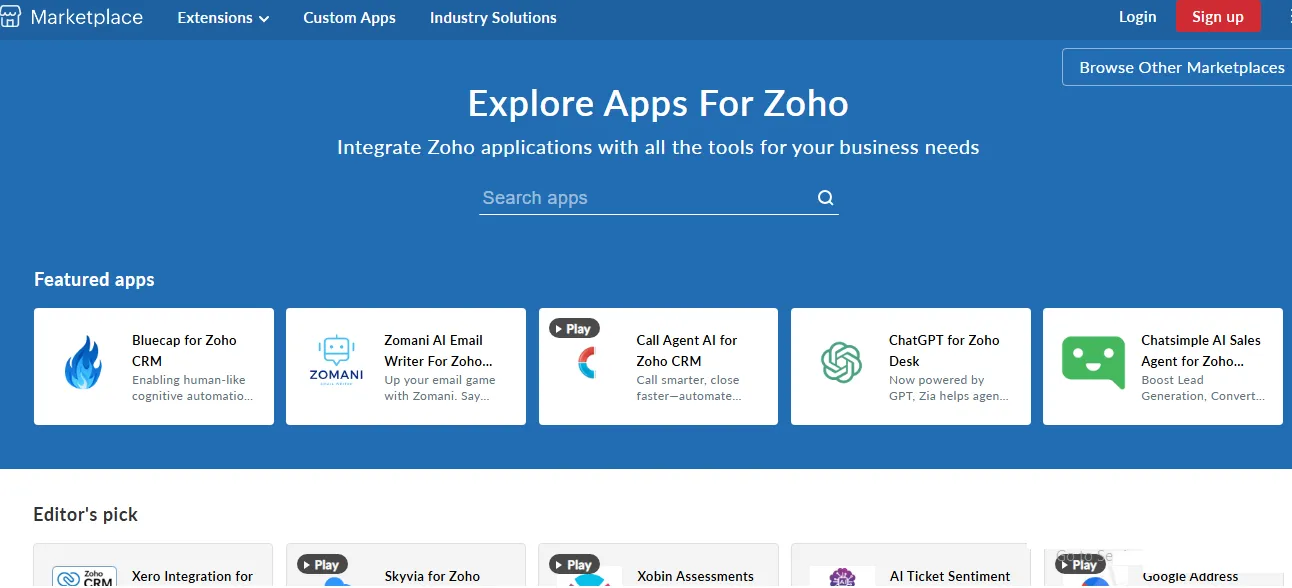
Right now, there are only a handful of apps built for Zoho Commerce (so few that some users even joke the app ecosystem is “basically non-existent.) One example is the Swatch for Zoho Commerce app, which lets you display color and image swatches on product pages to make them look a bit more polished.
There are also business integration tools like APPSeCONNECT, which help connect Zoho Commerce with ERP systems like Microsoft Dynamics 365 Business Central. Meanwhile, SAP Business One is a good, solid option if you need complex back-end syncing. But that’s about it.
Shopify apps & extensions
Shopify, on the other hand, is in a completely different league. Its App Store is massive, featuring over 13,000 apps built specifically to work with Shopify stores! Every app goes through a strict review process to make sure it’s high-quality, secure, and actually does what it promises.
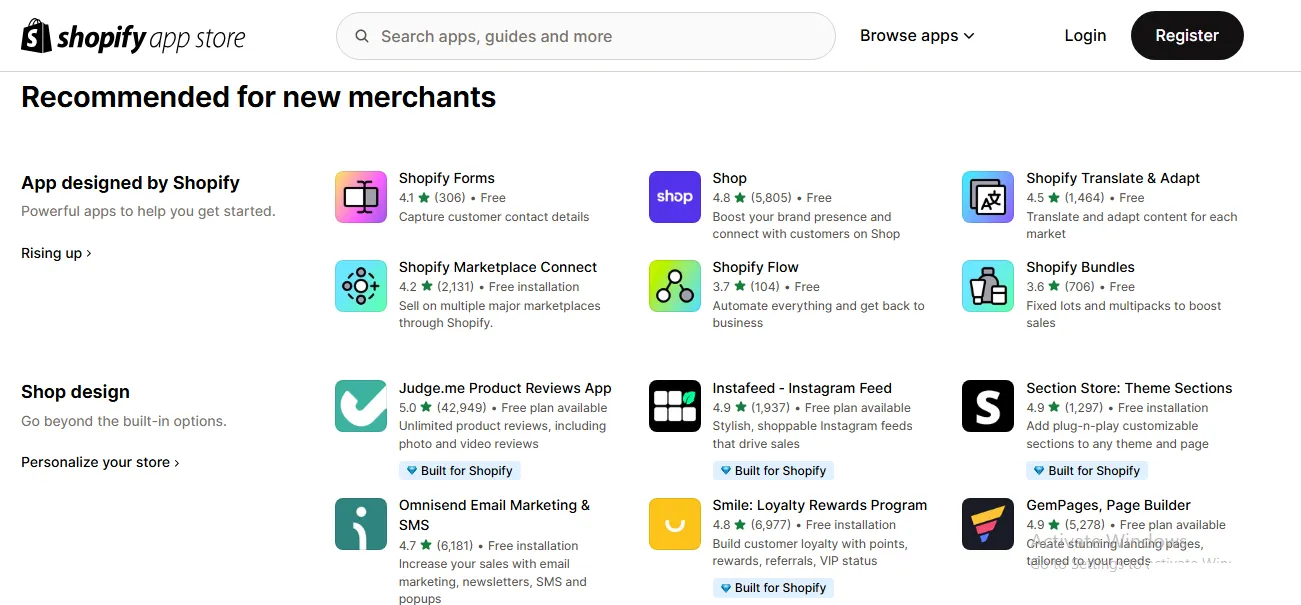
No matter what you need help with, chances are Shopify’s App Store has a solution:
- Marketing tools: Apps for email marketing, SEO, social media integration, loyalty programs, and more.
- Sales enhancers: Tools for upselling, cross-selling, discount management, and recovering abandoned carts.
- Customer support: Live chat systems, helpdesk software, review collectors — whatever keeps your customers happy.
- Store design: Theme editors, landing page builders, and apps for custom visual tweaks.
- Inventory and order management: Apps to automate inventory syncing, streamline order tracking, and connect with suppliers.
- Shipping and fulfillment: Solutions to calculate shipping rates, print labels, and work seamlessly with courier services.
And the list keeps growing, giving you endless ways to expand, customize, and fine-tune your store without needing to build everything from scratch!
The Verdict
Zoho Commerce’s extension library feels extremely limited and underdeveloped. Meanwhile, Shopify’s App Store offers a rich, constantly evolving ecosystem that supports just about any feature or integration you can think of. Hence, Shopify wins by a landslide.
5. Best for SEO & Marketing features: Shopify
Getting your online store up and running is only half the battle. The real challenge is making sure people can actually find it — and once they do, convincing them to stick around and come back for more.
In this section, we'll take a real-world look at what Zoho Commerce vs Shopify brings to the table:
Zoho Commerce SEO & marketing features
Zoho Commerce might not get a ton of hype, but when it comes to marketing features, it actually covers a lot more ground than you might expect.
Here's what you'll find:
- AI-powered product recommendations: Thanks to Zoho's smart assistant, Zia, your store can automatically suggest products based on what customers browse and buy. That way, it's easy to bump up the average order value without lifting a finger.
- Abandoned cart recovery: Zoho makes it easy to send automatic follow-up emails to customers who walked away mid-purchase. That's your second shot at closing the deal.
- Advanced coupon management: Want to run targeted promotions? Zoho lets you create discount codes based on customer type, product category, location, or usage limits. These functionalities give you a lot of control over your offers.
- SEO features: You can customize meta titles and descriptions, manage 301 redirects, and auto-generate sitemaps to help your site show up in search engines. Zoho even tracks page traffic and conversion rates so you can fine-tune your marketing strategies based on real data.
- Native integrations: Out of the box, you can connect with platforms like Zoho Campaigns, Mailchimp, Google Shopping, and Facebook Pixel. Plus, Zoho lets you create buy buttons that you can place on external websites – a simple way to drive more sales outside your main store.
Sounds great so far, right?
Well, there's a catch: Zoho's marketing tools work best if you stay within the Zoho ecosystem.
If you want to plug into external marketing tools or CRMs (especially ones outside the Zoho family), things can get complicated fast. You might need custom development work, and flexibility around key marketing touchpoints (like the checkout flow) feels a little boxed in compared to more open platforms.
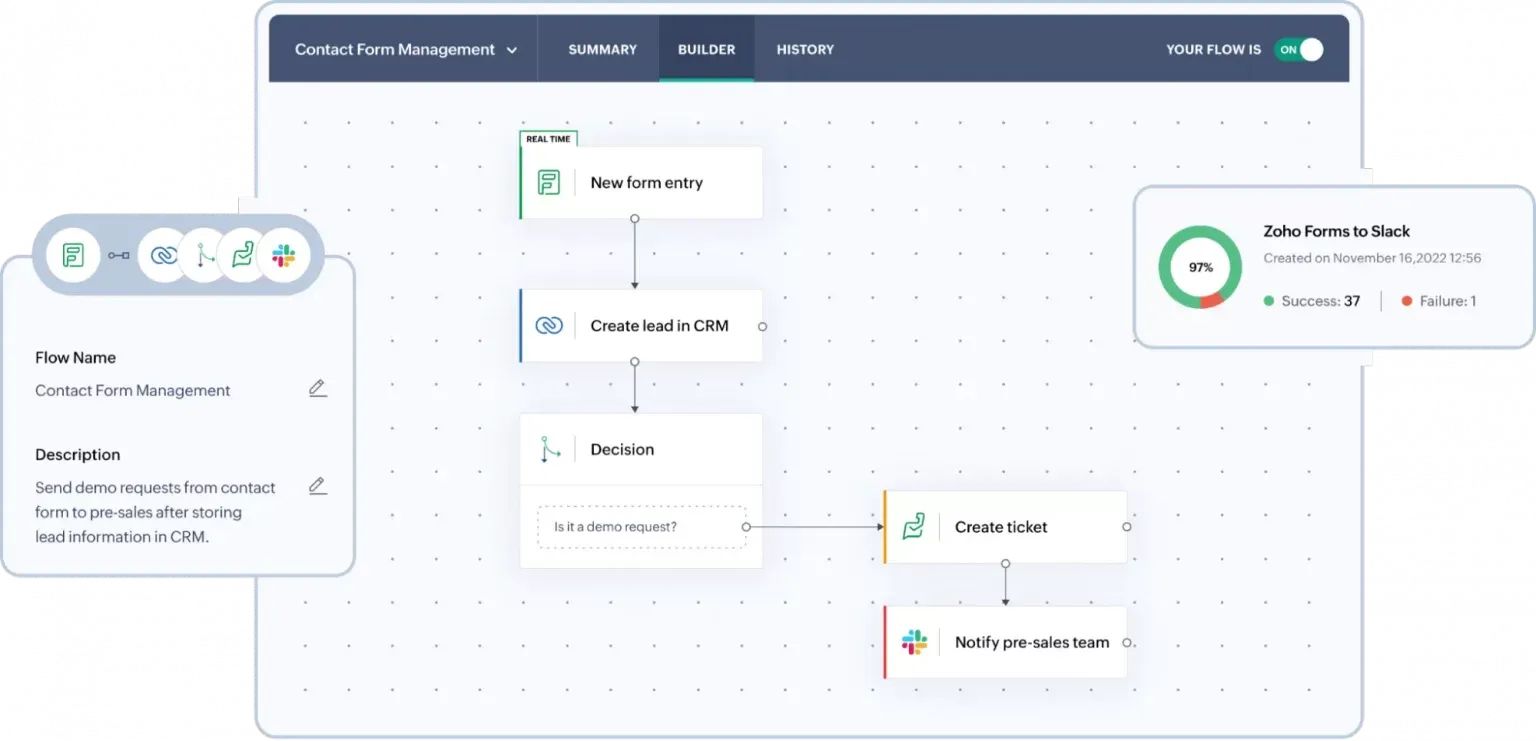
Shopify SEO & marketing
Shopify feels like it practically hands you a full marketing department from day one. Even on the basic plan, you get an impressively good toolkit, including:
- Unlimited customer contact management
- Targeted customer segmentation (easily create groups based on behavior, order history, and more)
- Email marketing with Shopify Email (you get 10,000 free emails per month, and the templates are simple to customize).
- Lead capture and live chat
- Marketing automation, abandoned cart recovery, gift cards, discount codes
SEO-wise, Shopify gives you the essentials done right, namely clean, structured URLs out of the box and automatically generated sitemaps and robots.txt files. And if you're a bit more advanced, you can even customize your robots.txt.liquid file directly to fine-tune how search engines crawl your site.

Now, Shopify's SEO settings aren't the deepest you'll find (you might miss things like full control over URL slugs for collection pages). Still, for 90% of store owners, it strikes a great balance between control and simplicity. And don't forget that if something's still missing, you've got Shopify's massive 13,000+ app store at your fingertips to fill any gap without heavy custom coding.
The Verdict
Both Zoho Commerce and Shopify give you a lot to work with. But if Zoho doesn't have the tool you need, you're kind of stuck. Meanwhile, with Shopify, if the built-in features don't cover it, there's almost always an app that will! For that reason, Shopify won this round, too.
6. Best for Customer support: Zoho Commerce
Even the best eCommerce platforms can't predict every question or technical glitch you'll run into. That's why the kind of support you get from Zoho Commerce vs Shopify can seriously impact your entire experience!
Zoho customer support
Zoho Commerce offers a segmented, hands-on approach to customer support. Instead of sending everyone into one general queue, Zoho routes you based on where you are in your customer journey:
- New customers who are just exploring their options can reach out via email for demos, pricing questions, or advice on plans via email. If you prefer speaking directly to someone, Zoho also offers regional phone support, with dedicated lines for users across the USA, North America, Asia-Pacific, Africa, and Europe.
- Existing customers are encouraged to troubleshoot independently at first by accessing tutorials, help articles, and community forums. If you can't find your answer there, you can submit a form to request personal support, and a team member will get back to you.
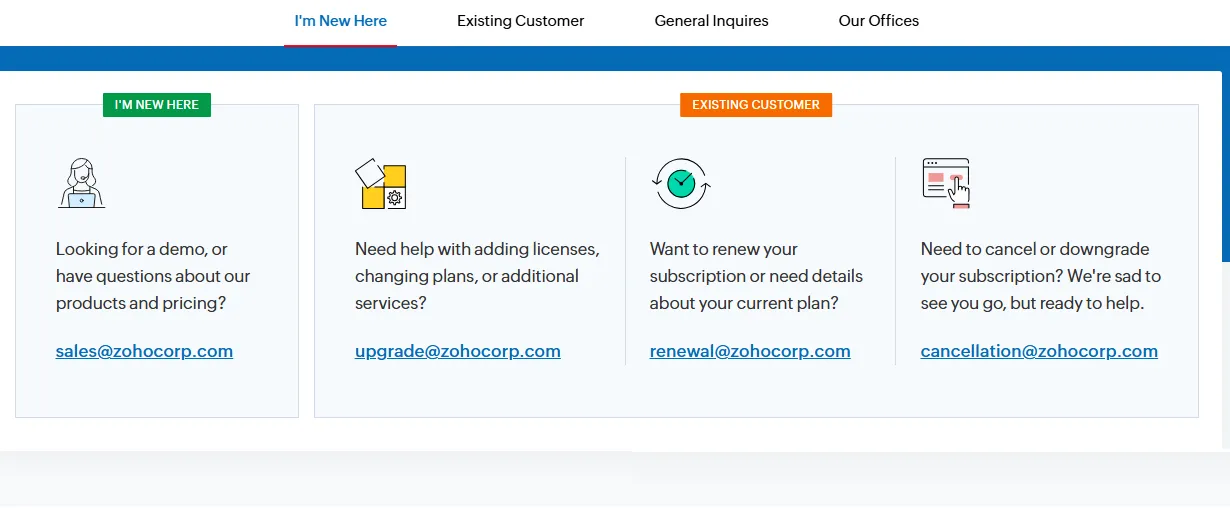
Overall, Zoho's structure feels deliberate. They offer clear, direct help if you need it, but they also expect you to try self-service options before escalating your issue.
Shopify customer support
Shopify, by contrast, leans heavily into a self-service support model. Their Help Center is packed with detailed guides, troubleshooting instructions, and how-to articles that cover everything from setting up your store to managing complex inventory workflows. Instead of relying mainly on email threads or regional call centers, Shopify encourages users to find their own solutions first.
Beyond the Help Center, Shopify gives you access to a huge community forum where thousands of merchants swap advice and share solutions based on real-world experience. There's also the Shopify Academy, which offers more than 80 free courses to help sharpen both your technical skills and your business know-how. If you still can't solve a problem, Shopify's built-in chatbot can guide you through common issues.
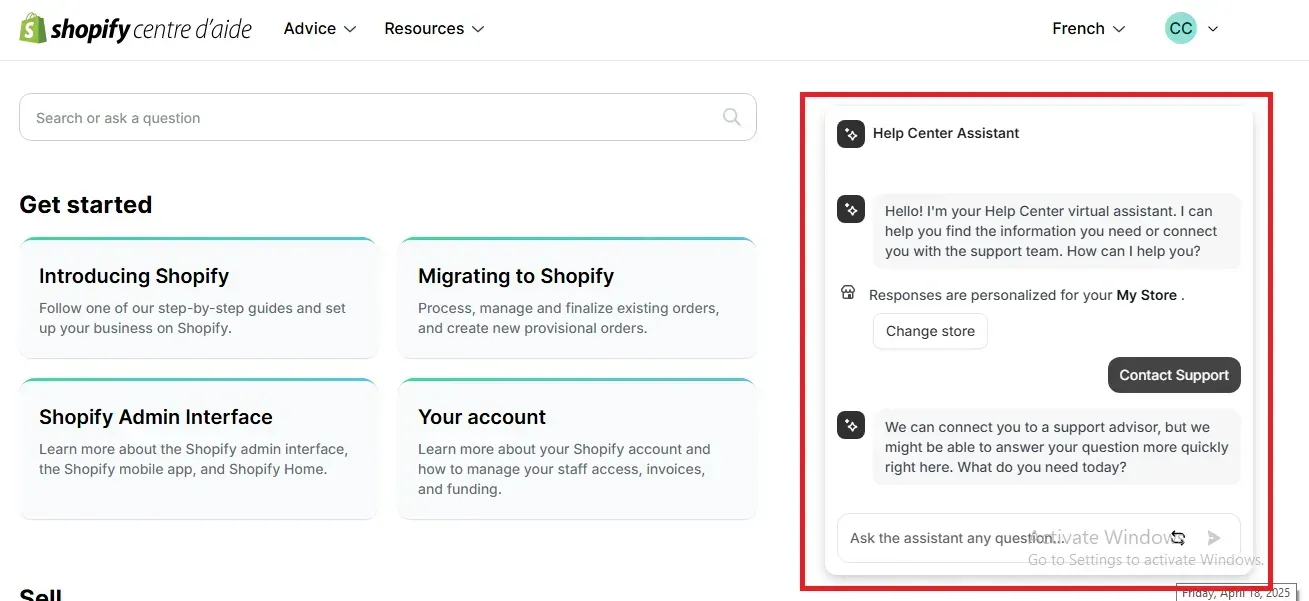
How about direct human assistance? Unfortunately, Shopify doesn't offer merchants any phone or email support. For more complex or store-specific problems, you're often advised to hire a Shopify Expert; of course, that usually means paying extra on top of your existing subscription.
The Verdict
Zoho Commerce comes out ahead in this comparison. Their system feels more personalized and thorough, with clear ways to reach the right team depending on your issue, plus regional phone support if you need to talk to someone directly.
7. Best for Pricing: Zoho Commerce
Lastly, do not get about pricing! Subscription costs, transaction fees, hidden charges… they all add up, and they can either make scaling your business smooth or painfully expensive.
Zoho Commerce pricing
For Zoho Commerce, there are just three plans:
- Starter: $27 per month
- Professional: $75 per month
- Advanced: $175 per month.
What’s even better? Zoho doesn’t charge you any transaction fees, no matter which plan you’re on! Whether you’re making ten sales or ten thousand, every dollar you earn stays in your pocket. For newer businesses or anyone trying to keep overhead low and predictable, that kind of transparency can be a huge game-changer.
Shopify pricing
Shopify, on the other hand, offers our main plans:
- Basic: $39 a month
- Grow (previously just called “Shopify”): $105 a month
- Advanced: $399 a month:
- Shopify Plus: starts around $2,300 a month for enterprise-level stores.
However, unless you exclusively use Shopify Payments, you’re going to be hit with additional transaction fees on top of your monthly subscription. On the Basic plan, expect 2% of every sale to go straight to Shopify. The fees shrink to 1%, 0.6%, and 0.2% as you move up to the higher tiers, but they’re still there nonetheless!
The Verdict
Looking strictly at the numbers, Zoho Commerce is the clear winner here. It offers lower starting prices, clean and simple plans, and – maybe most importantly – absolutely no transaction fees taking bites out of your sales.
Can You Switch from Your Current Platform to Zoho or Shopify?
Good news – you absolutely can! In fact, with the right help, it can be surprisingly easy.
And that's where LitExtension steps in to save the day. With over 12 years of experience and more than 200,000 successful customer migrations under our belt, LitExtension is the go-to expert for moving your store safely and efficiently. We know the ins and outs of all the most popular eCommerce platforms (including Zoho Commerce vs Shopify), and we're ready to help you make a clean, smooth transition without risking your valuable data.
You've got two options, depending on how involved you want to be:
- If your old and new stores are fairly similar, the automated migration service might be all you need.
- But if you don't want to lift a finger (or just don't want to deal with anything technical), you can choose the All-in-One migration service. LitExtension's experts will handle absolutely everything for you while you sit back and focus on your business.
Ready to make your move? Contact us today and let LitExtension help you start the next chapter for your store!
Zoho Commerce vs Shopify Alternatives
Though Zoho Commerce vs Shopify are two strong contenders in the eCommerce world, they aren't the only options out there. Depending on your specific needs, there may be other platforms that fit you even better. In this section, let's take a look at a few notable alternatives:
Platform | Advantages over Zoho Commerce | Advantages over Shopify | Limitations |
WooCommerce | Free core plugin; highly customizable; no vendor lock-in | Lower cost; full design freedom; huge plugin ecosystem | Requires WordPress setup and maintenance; hosting costs add up |
BigCommerce | More built-in features; no transaction fees | No additional transaction fees; strong B2B features | Fewer themes; more complex backend |
Wix eCommerce | Easier drag-and-drop design; faster setup | Lower cost for small stores; easier for beginners | Limited scalability for larger businesses |
Squarespace Commerce | Beautiful templates; simple pricing | Lower cost for small shops; sleek design templates | Limited payment gateways; basic SEO |
Magento Open Source | Extreme customization; full ownership | No transaction fees; unlimited scalability | Developer skills needed; high hosting and maintenance costs |
Zoho Commerce vs Shopify: FAQs
Is Zoho compatible with Shopify?
Not directly. Zoho Commerce and Shopify are two completely separate eCommerce platforms. You can't "merge" them or run them together as one store.
However, you can integrate certain Zoho products, like Zoho CRM, Zoho Inventory, or Zoho Books, with Shopify through third-party apps or custom API setups. This way, you can still connect some Zoho services to help manage your Shopify store more efficiently.
Is there a platform better than Shopify?
It really depends on what you need. Shopify is widely considered one of the best all-around eCommerce platforms, especially for businesses that want scalability, powerful features, and an easy-to-use setup.
However, if you're looking for more control over hosting and customization, platforms like WooCommerce (for WordPress users) or Magento Open Source might be better choices. Likewise, if you're focused purely on affordability and simplicity, something like Zoho Commerce or Wix could be a better fit. Make sure your choice matches both your goals and technical comfort level.
Does Zoho have an eCommerce platform?
Yes, and it's none other than Zoho Commerce! While it's best suited for small to mid-sized businesses (especially those already using other Zoho products), it's definitely a real player in the eCommerce space, not just an add-on.
Conclusion
By now, you should have a much clearer picture of which platform reigns superior between Zoho Commerce vs Shopify. At the end of the day, Shopify ultimately takes the win in most categories thanks to its superior scalability and powerful app ecosystem!
And if you’re feeling inspired to make the move to Shopify to transform your online store, LitExtension is here to make it happen. With 12+ years of experience and more than 300,000 successful store migrations, we have all the tools, expertise, and dedication needed to cater to your every need while ensuring your Shopify migration is 100% hassle-free.
For more information, check out our Shopify guide and join our Facebook Community.

